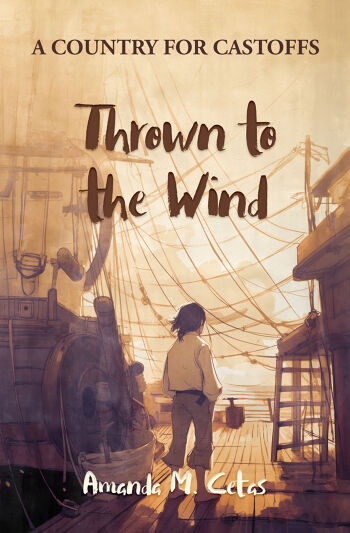
Based on a true story.
In October 1660, Etienne Gayneau rushes through the cobblestone streets of La Rochelle, France, to meet his cousin at the harbor. A ship carrying King Louis XIV's elite musketeers is docking. He dreams of becoming one himself, but has no idea that their arrival will force his Huguenot family to flee in the dead of night. His cousin has offered him a safe haven. Now he must choose - stay and pursue his dream or leave and face an uncertain destiny. Both choices are fraught with dangers. Either way his life will never be the same.
Assessment:
Plot/Idea: Cetas has masterfully used her own ancestral background and history to create a fast paced adventure that will engage middle grade readers. Strong life lessons are sprinkled throughout the narrative, including the importance of choosing the correct path in life, giving the plot depth and substance.
Prose: Thrown to the Wind is well-written, with vivid imagery that brings the time period and landscape to life. Readers will experience the perilous journey alongside the main character—and understand his indecision in plotting the course of his life.
Originality: Thrown to the Wind is elevated by its exciting events as well as the story's strong themes that capture crucial life lessons. Cetas draws from her own ancestry, blending a time period that was unyielding in social structure and fraught with religious persecution into a breakneck adventure that is both entertaining and intriguing.
Character/Execution: The main character exhibits strength and boldness, gaining confidence throughout the novel. His coming-of-age journey is deeply meaningful and absorbing—young readers will want to meet him.
Date Submitted: August 16, 2023

Cetas introduces Etienne as an insecure boy cowering in the imposing stone city, with its rigid social structure and history of religious oppression. His father’s stubborn adherence to Protestantism separates Etienne from his Catholic cousin (and only friend), and instead of finding solace among fellow Huguenots, he’s bullied for being a poor artisan’s son.All Etienne knows for certain is that he doesn’t want to be like his stern, imposing father, a builder of stone and mortar potager’s stoves, whose rigid work ethic is second only to an unwavering devotion to God. Cetas skillfully plots Etienne’s journey as an uphill climb full of switchbacks, with determination gradually replacing indecision, and a clear-eyed faith supplanting fantastical visions.
Thrown to the Wind proves an apt title, capturing the refugee’s plight: upheaval and uncertainty, exhaustion and anxiety, trepidation and hopefulness. Cetas’s debut also details the era’s arduous shipboard travel: instead of feeling unmoored, Etienne quickly finds his sea legs and gains confidence as a cabin boy who can cope with precarious situations. Recreating her ancestors’ path from persecution to possibility, Cetas focuses on a boy who doesn’t fully understand the historical forces affecting his family, but methodically charts his own course to maturity.
Takeaway: The vivid story of a boy discovering his value on the perilous voyage of early American settlers.
Great for fans of: Kathleen Benner Duble’s Quest, Elizabeth George Speare’s The Sign of the Beaver.
Production grades
Cover: B
Design and typography: A
Illustrations: N/A
Editing: A
Marketing copy: A-


